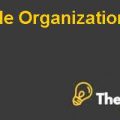
THE DEEP WATER HORIZON OIL SPILL RESPONSE REPORT Case Solution
Introduction
The Deepwater Horizon Oil rig had sank on the 20th of April, 2010 and it was one of the biggest accidents of the oil spills in the entire history when more than 200 million gallons of the oil were spilled over the period of 87 days (Tunnell, 2011). The owner of the well BP and the owner of the operator of the Deepwater Horizon, Transocean had been named as the responsible parties of this massive oil spill by the United States Coast guard.
This was a project failure of immense proportions. This project had went on from being just an oil exploration project to a huge program consisting of portfolio of different projects which were related to stopping the oil leak, dealing with the families of those workers who were killed on the oil rig, capturing the oil from the ocean and the well, cleaning, saving the wildlife and the environment, dealing with the employees and shareholders, dealing with the public, dealing with the governments and responding to the human needs (Donovan, 2010).
The project’s budget had increased from 500 million to 100 billion programswith long lasting and extensive negative media coverage (BP, 2011). This report attempts to analyze the key project management issues critically within this project and the project management concepts in a critically comprehensive manner. Finally, recommendations and improvements for future projects of BP have also been made.
Evidence
The Deepwater Horizon oil project should have been managed based on the core concepts of project management. First of all, the all the parameters of cost, schedule and quality along with the creation of a detailed project plan should be done by the project manager. Single objective should be developed with a detailed schedule for the completion of the project.Project management is leader intensive therefore, the project manager needs to act as a leader who should formulate teams, work breakdown structure, deadlines of all activities, communications plan, lines of communication for the project members.
The work breakdown structure would define the scope for the project. After this, a detailed resource plan in terms of cost and time requirements and human resource plans needs to be also devised to accomplish each of the project activity and avoid critical paths. Along with this, the risk management plan should be formed which is a critical component of project management. Proper risk identification, analysis, mitigation strategies and control measures should be formulated. The project manager will have to achieve a trade off between time, cost and the risks associated with each decision. This was the main cause of the failure of the BP oil project.
Analysis
The analysis has been performed in the light of the evidence described in the previous section and all the core areas of project management have been analyzed as shown below.
Project Manager Leadership
The Deep water Horizon rig project had several players, which were involved in the main project and there was no particular leader or project manager assigned to this whole project as it progressed. The interrelationship between the several companies attached to this project had created a complex structure and there were conflicting interpretations of responsibilities and accountability (Stevens, 2008). This project was a failure of the management as all the three firms, Halliburton, Transocean and BP had ignored critical warning signs and did not take any precautions (Christina Ingersoll, 2010). As the project’s management is leader intensive however,in this case, especially the leaders of BP were reprehensible and culpable as they had inspired and created a culture which ignored expert advice, hid facts, overlooked all the warnings related to safety issues and sanctioned extreme risk taking which led to this ultimate environmental disaster.................
This is just a sample partial case solution. Please place the order on the website to order your own originally done case solution.













